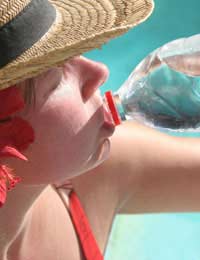Surviving in Extreme Heat

Extremely high temperatures are just as dangerous as extremes of cold when it comes to a survival situation and it’s important to be able to recognise the different kinds of heat related illnesses you might encounter before you can treat them effectively.
Heat Exhaustion
This is probably the most common heat related illness and is caused by the loss of body water and salt and symptoms tend to include a headache, profuse sweating, weakness, dizziness, irritability, cramps and even mental confusion. The casualty might also appear to have pale yet clammy, moist skin. It’s important to get the casualty into the shade and make them lie down and loosen their clothing. Sprinkle water over the casualty and fan them. It’s important that the casualty drinks regularly - only small amounts but every 3 minutes or so and they should rest and remain still and calm.Heat Stroke
Also caused by the loss of body water and salt, heat stroke also affects the body’s natural ability to cool itself and a person can die if they’re not treated quickly. Symptoms include hot and dry skin and a visible lack of sweat. Once again they can experience a headache, dizziness, nausea, vomiting and heat stroke can often be detected by the casualty having a racing pulse. Mental confusion can also occur which can often precede the casualty becoming unconscious.You need to get the casualty to lie down in the shade, loosen their clothing and pour water over them. Your use of water can be very liberal here and it doesn’t matter even if you suspect that the water might be polluted, they should be soaked. Arms, legs and body should be massaged and if the casualty regains consciousness you should give them small amounts of water to drink every 3 minutes or so.
Heat Cramps
This is caused by the loss of salt through excessive sweating. The muscle cramps are usually in the arms, legs and abdomen area and can just start out as mild discomfort whilst you’re undertaking physical activity in hot weather. However, these symptoms can become more severe if you don’t stop your activity straight away as soon as you feel signs of discomfort. Getting in the shade and taking in fluids is the first action you should take and if the symptoms are severe, you should treat them in the same way as you would heat exhaustion.Surviving Heat Related Conditions
Wherever possible, you should not stay exposed to the sun and heat any longer than is absolutely necessary and look for shade. In a survival situation, it’s better to do any work which involves physical exertion late at night when it’s cooler. Not only will this be more bearable and help to expend your energy more sensibly, you’ll not sweat as much which will help with the retention of body fluids and make you less prone to dehydration. Keep an eye on the colour of your urine. Dark coloured urine means that you’re running the risk of dehydration so you need to drink more and remember that you’ll need to drink more in extreme heat to make up for the fluid lost through sweat.By knowing the ways in which to recognise and to treat heat related illnesses and ways to help prevent them happening in the first instance, your chances of survival will improve significantly as a result.
- Cold Weather Survival
- The Boy Scout Handbook and Survival
- Using the Stars to Navigate
- Surviving a Chemical Attack
- Dangers and Benefits of Leeches
- Surviving in the Desert
- Intestinal Parasites and Diarrhoea
- How to Communicate With the Locals
- Preventing and Treating Snake Bites
- How To Survive A Forest Fire
- How to Get Out Of A Mud Bog (Quicksand)
- Handling An Evacuation Procedure
- Prepare to Stay Over Night
- How to Cross Rivers, Streams and Rapids
- Surviving at Sea
- How To Survive Worst Case Scenarios
- Surviving an Animal Attack
- Surviving Natural Disasters
- Dealing with Insects in a Survival Situation
- Dealing With Children in a Survival Situation
- Predicting the Weather
- Preventing and Treating Frostbite
- Survival Psychology


Re: How to Get Out Of A Mud Bog (Quicksand)
I was 8 years old, my family went to visit our neighbors where we previously lived in Tool,Texas. The family had…
Re: How to Get Out Of A Mud Bog (Quicksand)
I was sinking in a mud bog yesterday for 3 hours until I was pulled out. How do I cope now?
Re: Dangers and Benefits of Leeches
Can it penetrate completely into the body through navel ? If, then how one can know that it has entered into body ? And what…
Re: How To Survive A Forest Fire
I like cheese.... ????????????????????????????
Re: Dangers and Benefits of Leeches
The easiest way to remove a leech from skin is just by sprinkling salt over the leech which would immediately detaches itself…
Re: Dangers and Benefits of Leeches
I'm 14 and was swimming st Brady's run in beaver county and I got bit by a leech.. I would of never knew unles my boyfriend…
Re: What Are Survival Seeds?
The other evening, I found all my matches were damp and I had to ignite my wood burning stove using a rolled up piece of paper and my…
Re: Where Can I Try Out my Survival Skills?
i been doing some survival practise is my back garden but i could use some new bet cheap and relieable gear. thank you
Re: Surviving in the Desert
Hi I am in the process of doing research for a novel. The main characters are trapped in a desert and there is an on coming sandstorm.…
Re: How to Start a Fire
So lets just say, I am aware this sounds crazy but hear me out, what if there was a zombie apoccolypse (Have no frickin idea how to spell…